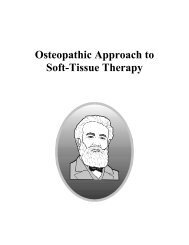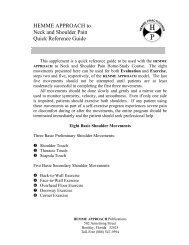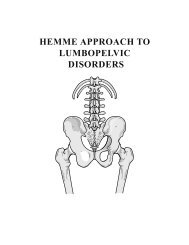HEMME APPROACH TO SOFT-TISSUE THERAPY
HEMME APPROACH TO SOFT-TISSUE THERAPY
HEMME APPROACH TO SOFT-TISSUE THERAPY
You also want an ePaper? Increase the reach of your titles
YUMPU automatically turns print PDFs into web optimized ePapers that Google loves.
If joints and the agonist are normal, the main factor limiting ROM is the<br />
tissue extensibility of the antagonist. If the antagonist fails to lengthen<br />
normally during contraction of the agonist, the joint's range of motion will be<br />
limited. This explains why active range-of-motion testing measures the<br />
strength of the agonist, the length of the antagonist, and the amount of motion<br />
available to a specific joint. The three main ways to increase the active ROM<br />
are strengthen the agonist, lengthen the antagonist, and loosen the joint.<br />
The following table defines active, passive, active-assisted, and resisted<br />
range-of-motion testing.<br />
Active range-of-motion testing: the force for the movement is provided by<br />
the patient without assistance or resistance from the examiner.<br />
Passive range-of-motion testing: the force for the movement is provided by<br />
the examiner without assistance or resistance from the patient.<br />
Active-assisted range-of-motion testing: the force for the movement is<br />
provided by the patient with some assistance from the examiner.<br />
Resisted range-of-motion testing: the force for the movement is provided by<br />
the patient and works against resistance from the examiner.<br />
For the safety of the patient, active, passive, and active-assisted range-ofmotion<br />
testing should always be done first, and resisted range-of-motion<br />
testing last. Active range-of-motion testing gives the examiner a chance to<br />
observe the patient's ROM with gravity as the only outside force. If the active<br />
ROM is normal, the final step is resisted range-of-motion testing.<br />
If the patient fails active range-of-motion testing, the next step is using<br />
passive range-of-motion testing to evaluate the ROM. If the patient's ROM is<br />
incomplete, the probable causes are joint dysfunction, spasm, or contracture. If<br />
the patient's range of motion is normal, active-assisted range-of-motion testing<br />
can be used to identify weakness. Possible causes for weakness are neurologic<br />
dysfunction, lack of motivation, pain, disuse atrophy, or fatigue. If a patient<br />
fails muscle testing at any level, it is normally better to stop and treat the<br />
problem than to continue with muscle testing.<br />
30<br />
<strong>HEMME</strong> Approach to Soft-Tissue Therapy









